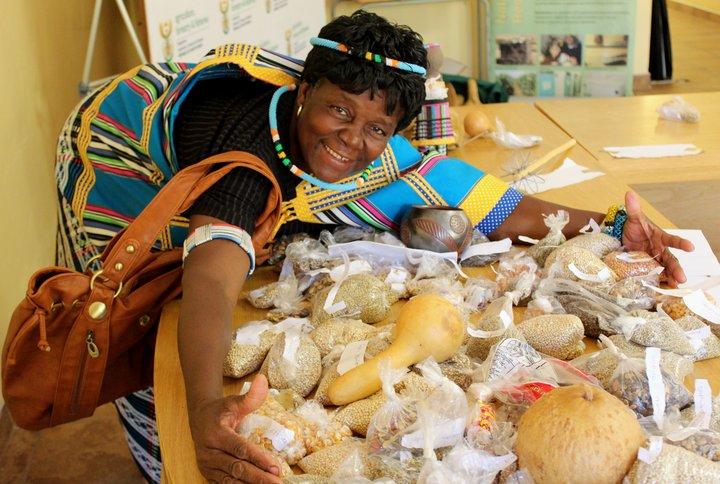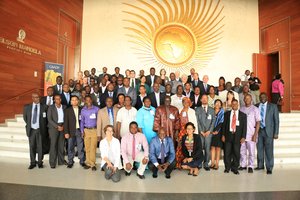Seeds without borders

This month, as the 2015 United Nations Climate Change Conference of the Parties opens in Paris, M. Ann Tutwiler explains why 11 African countries recently got together to exchange and use plant genetic resources to adapt to climate change.
This month, as the 2015 United Nations Climate Change Conference of the Parties opens in Paris, M. Ann Tutwiler explains why 11 African countries recently got together to exchange and use plant genetic resources to adapt to climate change.
“There is a change in the weather. Even our village is changed in temperature - it was a very cold place in the past but now it has become hot”.
These are the words of Tilhaun, a farmer we are working with in Ethiopia. Tilhaun, just like farmers around the world, is feeling the effect of climate change on his farm, every day, and every season.
In East Africa, climatic models agree that temperature will increase everywhere. They don’t know if it will rain more, or if it will rain less. But rain patterns are shifting and becoming increasingly unpredictable. Some crops which are vital for food security in Africa’s rain-fed agricultural systems – such as maize, common bean and banana – are facing climate-related losses of up to 40%. So how can farmers adapt to these uncertainties?
One way is to diversify their farms – to find varieties of the crops they are already growing, or even different crops altogether – which are better adapted to the changing climatic conditions. Sometimes those crops (and the genetic basis of their desired traits) can be found within a country’s own borders. But increasingly, farmers and breeders have to look for gene-based traits in plant genetic resources from other countries and continents – no one country has all the genetic resources it needs to adapt to climate change.
The recently adopted Sustainable Development Goals, in particular Targets 2.5 and 15.6, clearly specify the need for countries to exchange genetic resources to achieve multiple outcomes, including adaptation to climate change. This means that the people who manage and conserve plant genetic resources all over the world need to work together to pool those resources and create a networked collection.
There are two international agreements on how countries exchange seeds beyond their borders – the International Treaty on Plant Genetic Resources for Food and Agriculture (Plant Treaty) and the Nagoya Protocol. Both have similar objectives.
The Plant Treaty creates a multilateral system whereby countries virtually pool and share the plant genetic resources of 64 crops and forages for food and agriculture-related purpose. It is designed to facilitate cooperation between national governments, genebanks, researchers, plant breeders, development agencies and farmers to conserve, add value to and exchange plant genetic resources and to share benefits associated with their use (through an international fund). It also recognizes farmers’ rights, encouraging governments to put systems in place to protect farmers’ traditional knowledge and to participate in decision-making processes.
The Nagoya Protocol is a supplement to the 1992 Convention on Biological Diversity, designed to promote the sharing of benefits arising from the use of genetic resources. It promotes bilateral negotiations access and benefit-sharing agreements between providers and users of genetic resources and traditional knowledge. It also commits Member States to engage indigenous people and local communities (including farmers) as stewards of genetic diversity, and promotes their rights to be involved in decision-making about the uses to which genetic resources and traditional knowledge is accessed and used.
Bioversity International works with a range of organizations including the Secretariats of the Convention on Biological Diversity, the Plant Treaty and the African Union Commission to demystify gray areas concerning how the two agreements relate to one another, and to increase stakeholders’ ability to implement and take advantage of the development potential of both agreements in mutually supportive ways. In recent years, this work has been supported by the Government of the Netherlands (DGIS).
A meeting in Addis Ababa, Ethiopia last week, co-organized by Bioversity International and the ABS Capacity Strengthening Initiative, is one such example. We brought eleven country teams together – Benin, Burkina Faso, Côte d’Ivoire, Democratic Republic of the Congo, Ethiopia, Kenya, Madagascar, Mali, Malawi, Senegal and Uganda – to look at policies to deal with the impact of climate variability on their agricultural systems, and identify and access the plant genetic diversity they need and share associated benefits.
What was really unique about this meeting was that country teams included five expert focal points – for the Plant Treaty, Nagoya Protocol, climate change and agriculture, GEF and Finance & Planning. For some, it was the first time they became aware of the potential of agricultural biodiversity to help them meet their national development goals, including climate change adaptation, food security and poverty alleviation. It was also, for many, the first time they had the opportunity to meet and work together with different focal points with similar objectives from within the same country.
 During the week, the teams worked together on options for longer-term mainstreaming of the two agreements into national development plans, medium term expenditure frameworks, climate change adaptation plans, and biodiversity strategic action plans.
During the week, the teams worked together on options for longer-term mainstreaming of the two agreements into national development plans, medium term expenditure frameworks, climate change adaptation plans, and biodiversity strategic action plans.
They also attended a meeting at the African Union, to meet with the Permanent Representative Committee Sub-committee on Programs, to identify opportunities and constraints for implementing the two agreements together to advance national development priorities and food security.
As the 2015 United Nations Climate Change Conference of the Parties opens in Paris this week, the mutual implementation of the Plant Treaty and the Nagoya Protocol, must be part of country strategies to adapt to climate change.
To end with the words of Mamta Kumari, another farmer we work with in India: “It is definitely hotter. This has been the situation for the last 5 years. Now both summer and winters are extreme. The rain that we had recently for 2 days, it has done nothing but harm all the crops.”
- Read more about the ‘Mutual implementation of the International Treaty on Plant Genetic Resources and the Nagoya Protocol for broader national development goals'
Partners
This week-long workshop was held in Addis Ababa, Ethiopia, November 16-20, and organized by Bioversity International and the ABS Capacity Strengthening Initiative, in partnership with the International Treaty on Plant Genetic Resources for Food and Agriculture, the Convention on Biological Diversity, the African Union, the CGIAR Research Program on Climate Change, Agriculture and Food Security and the Japan Biodiversity Fund.
Photo top: Farmer diversity fair, South Africa. Credit: Bioversity International/R. Vernooy
Photo bottom: Participants of the workshop attended a meeting at the African Union. Credit: Bioversity International
